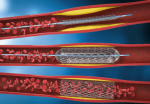The impact of diabetes on the development of cardiovascular disease is widely known, with a strong association with extensive and diffuse coronary artery disease. Decision-making regarding how to revascularize patients with multi-vessel disease is a complex process. In this context, coronary artery bypass grafting (CABG) has been recommended over percutaneous coronary intervention (PCI) based on...
TCT 2023 | CLASP IID Study 1-Year Results: PASCAL vs. MITRACLIP for Degenerative Mitral Regurgitation
The negative impact of mitral regurgitation (MR) on patient mortality, morbidity, and quality of life is widely recognized. However, only 15% of patients are referred for surgery due to their high surgical risk and low ejection fraction. Transcatheter edge-to-edge repair has become an important alternative for this group of patients. For subjects with degenerative MR,...
Complex Coronary Angioplasty in Elderly Patients: Problem or Solution?
Cardiovascular disease is the leading cause of death in elderly adults (individuals aged 75 years or older). In turn, coronary heart disease is one of the main causes of morbidity in this population. In addition to anatomical complexities, there are other factors that may complicate its management, such as polypharmacy, frailty, and procedure-related risks. All of...
Cause of Cardiac Death after TAVR at Present
Cardiac failure (CF) and sudden cardiac death (SCD) stand out as two of the main causes of death in patients with aortic stenosis. Although transcatheter aortic valve intervention has shown higher survival, these two continue to be the main conditions leading to patient death at followup. In its early days, TAVR also showed benefits, but...
Left Main Coronary Artery PCI: In What Scenario Could We Not Use IVUS?
Lesions in the left main coronary artery (LMCA) continue to pose a significant challenge. The use of coronary imaging before percutaneous coronary implantation (PCI) has proven useful in analyzing the lesion, identifying the presence and location of calcification, and determining lesion length in the LMCA, the left anterior descending artery, and the circumflex artery. Various...
Treatment and Gender-Based Outcomes for Coronary Bifurcation Stent Placement: Report from the e-ULTIMASTER Registry
Approximately 20% of all percutaneous coronary interventions (PCI) are performed on bifurcation lesions, which continue to pose a challenge in terms of strategy: how many stents to use, what is the most suitable strategy, and when to transition from a single stent to two during the procedure. Additionally, the use of two stents in these...
TriClip: Good Outcomes After a 2-Year Follow-up
Severe tricuspid regurgitation (TR) is an underestimated condition in healthcare systems. However, it is more common than believed, especially in individuals over 65 years of age. This condition is linked to hospitalizations due to heart failure, mortality rates, and a progressive decline in quality of life. Surgery to treat TR on its own is complicated,...
Anti-Lipid Therapy in PCI Patients: Monotherapy with Statins or Combination?
According to several studies, in patients with high-risk atherosclerotic disease, such as those affected by coronary artery disease, achieving target LDL levels through high-intensity statin therapy has been shown to lead to a significant reduction in long-term cardiovascular events. Therefore, the management of dyslipidemia has become a fundamental pillar of secondary prevention. However, reaching such...
BIFURCAT Registry: 1 or 2 Stents? Treatment of Side Branch (Medina 0.0.1) Lesions According to Real-World Data
Coronary bifurcation lesions have been a subject to debate, with different approaches by various medical teams. These lesions often carry a higher risk of ischemic events compared with lesions at non-bifurcated sites. The main strategy, supported by medical society recommendations and clinical guidelines, involves using provisional stenting with one stent to minimize the number of...
Use of Drug-Coated Balloons in De Novo Lesions in Large Coronary Vessels
Drug-coated balloon (DCB) angioplasty is emerging as a novel treatment for coronary artery disease. Studies evaluating this strategy have demonstrated clinically non-inferior outcomes compared with those of drug-eluting stent (DES) implantation in patients with in-stent restenosis and de novo disease in small vessels. However, evidence for the use of DCBs in large coronary vessels is...









